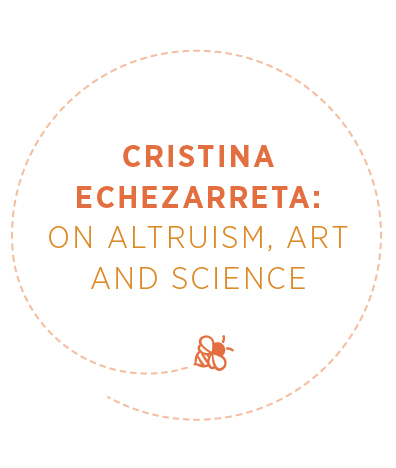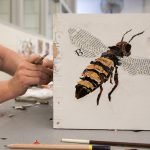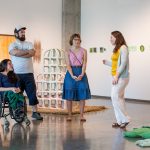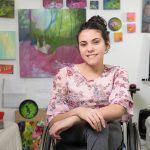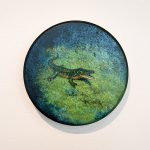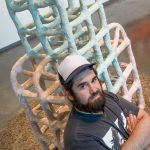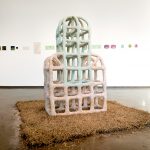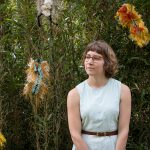Cristina Echezarreta
Can prison inmates become creative collaborators?
Idea Lab Mini Grant recipient and MFA student Cristina Echezarreta says, yes, they can.
In the process of working with the Georgia Prison Beekeeping program, the graduate student has brought her twin interests, art and entomology, together. And this year, she adopted similar ideas in order to curate an art exhibition with fellow artists at the Lamar Dodd School of Art.
Seems Miami-born Echezarreta helped pollinate yet another good idea.
By: Cynthia Adams | Photos By: Nancy Evelyn
Echezarreta’s name, pronounced with her lilting Spanish inflection, almost sounds like the soft whirring of wings, the flight of the bumble bee.
Fine with her! She likes bees. She laughs at bee puns. She talks to beekeeping groups, students, faculty—anyone who will queue up and listen, to share that the honeybees live in collective, productive, hive harmony.
The love and care of bees, with inherent altruism and balanced ecosystems, is transformative, Echezarreta says.
Observing their industry, cooperation and purpose can be transformative for artists like her who often work in isolation. As she also knows, beekeeping can be transformative for inmates who, just like bees, live in cells and are subject to systems and social mores.
But bees, art, inmates and collaboration. Can these things possibly connect—or have lessons for the rest of us?
Yes.
The Flight of the Honeybee
Cristina Echezarreta first got a bug for bees before she relocated to Georgia to enter graduate studies at the Lamar Dodd School of Art. When she sought an MFA program, she wanted to find a school both strong in art and in entomology—her second love.
She found both at UGA.
When Echezarreta spoke to a group of Athens-area beekeepers last fall, she explained how the Georgia Prison Beekeeping Project happened to engross her.
Soon after arriving in Georgia last year, Echezarreta reached out to Jennifer Berry, lab manager for the UGA Honeybee program. And soon after they connected, she was deeply involved with the Georgia Prison Beekeeping Project, a relatively new project that had grown beyond all expectations.
The Georgia Beekeepers Association had pioneered the prison beekeeping program in 2014.
As Echezarreta told Athens beekeepers this past October, there are more than 52,000 people incarcerated in Georgia. Inmates from five prisons involved with beekeeping are now pursuing beekeeping training as a vocational option or interest.
According to an interview with Berry in UGA’s Research magazine, approximately 80 prisoners have become certified beekeepers since its inception four years ago. The zeal of the prisoners for beekeeping seems equal to that of the volunteers who support the endeavor.
In short time, Echezarreta’s volunteerism with honeybees led her to create an artful project which enabled inmates to work together, conceptualizing and painting hive boxes.
As she flipped through slides, Echezarreta demonstrated the relationship between the volunteer project’s humane outreach efforts with the prison population, and compared historical efforts to help prepare inmates for productive lives outside prison.
“Five prisoners have passed their journeyman’s designation!” Echezarreta announced to the wowed audience of beekeepers.
“That’s not easily done!” someone marveled aloud.
Then she deviated from the volunteers’ humanistic efforts and showed slides of bee-inspired art by Ren Ri, a Chinese geometric sculptor who works in beeswax, and the “Green Porno” of actress Isabella Rossellini. With a casual sleight of hand, she had connected beekeeping and art.
The Art Behind the Artist
Echezarreta was born in Miami to a Cuban father who came to the United States at age nine, and a Venezuelan mother. Their Miami Springs home was bilingual. Art was highly valued; the walls were hung with prints of some of her mother’s favorite artists.
She was swiftly acculturated into both the culture of Miami and the rich diversity of her parent’s respective backgrounds. She remained in Miami through her early college years, enjoying the richness of the art scene there.
Meanwhile, Echezarreta also became interested in science.
“I did my associates of art at Miami Dade College. I had taken a biology class, then a botany class. I read an article called The Plight of the Bees in Time, and I was already interested in honeybees. Then, I began thinking about colony collapse disorder.”
She transferred to Florida State University and still had honeybees on her mind. She acted upon that interest, seeking out beekeepers off campus. Echezarreta pauses as she discusses the evolution of her fascination. “Three years ago, I went to hear a beekeeping association meeting in Tallahassee while at FSU; now, here I am doing the same thing.”
The more Echezarreta knew about bees, the more she admired honeybees’ social involvement and collaborative behavior. She sought a way to maintain her growing scientific interest, potentially through how that might interplay with the making of art.
“There was no entomology department at FSU. In my ceramics class, I proposed a dinner party to engage with the beekeepers and see how art was connected.” Her proposal worked.
When it came to graduate studies, Echezarreta knew exactly what she wanted. She sought for and found both a top-rated MFA program at UGA along with an entomology program, which offered the chance to continue in both her interests.
Echezarreta says engagement with the honeybee lab enriches how she works at Lamar Dodd. “It builds community. Collaboration. I found myself caught in that flow.”
When she speaks of flow, it is in the classic sense of heightened awareness and creativity.
“There is more of the altruism and environmental,”
she says.
“I’m looking at working with the bees in a non-literal way. I almost enjoy having multiple things I’m involved with—the prison project, then I go to my studio and work on my giant fruit.” She creates giant pieces of fruit, figurative textiles, in her studio which is located at the Thomas Street complex on campus. These, too, are redolent of her Miami past.
“I’m making sketches to make more giant fruit/soft sculpture,” Echezarreta says. “I fell in love with it, its repetition. My grandmother sewed.” Her father, who died recently, also made jewelry, necklaces, and leather work as a hobbyist and enjoyed various forms of art making.
“He made archery bags, all kinds of things. He had a giant sewing machine, but made to sew leather.”
Echezarreta observed her father making things by hand, something he did after hours and also as he battled illness. “I loved that repetition (in sewing pieces); it’s transcendent, doing something over and over. He also painted.”
Her mother, who now operates a food truck in Puerto Rico, expresses her creative self through cooking. She was also the one who formally introduced Echezarreta to art.
“My mom does not make art but she took me to museums. When I was in Spain this past summer I went to El Prado, the Museo Nacional Del Prado in Madrid, and she said she had been there many times.”
Barcelona was a special favorite, as she has family in northern Spain and the Basque Guggenheim is also there. “My mom would see something in a magazine (art related) and say, it’s free, I’m going! Also, I like talking to people and communicating with people…my culture is already oriented to giving back in the community.”
When she completes her MFA in 2020, Echezarreta
has fluid plans.
“What I really want to do is outreach. I would love to work for a science museum, building exhibits, and doing community-based work.”
And then, there is teaching. “I just studied abroad in Cortona and visited Spain…now I cannot stop thinking about teaching there.”
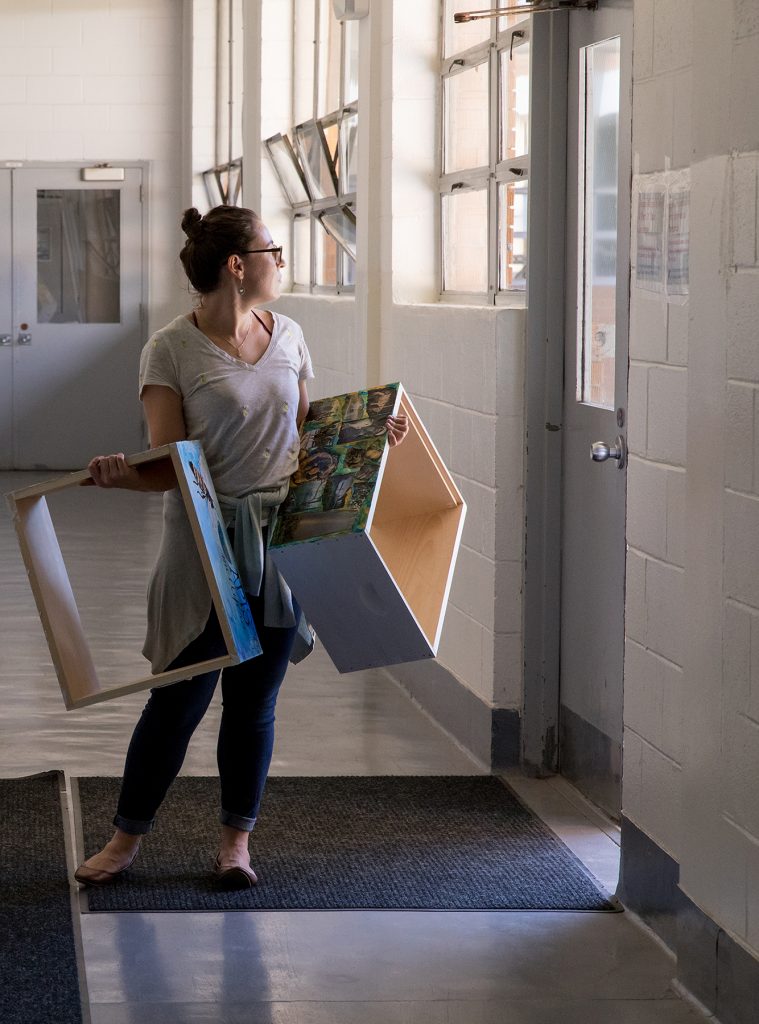
CRISTINA ECHEZARRETA WON GRANTS IN ORDER TO FUND HER OWN BEEKEEPING EQUIPMENT AND ALSO SUPPORT AN ART PROJECT SHE HAD IN MIND FOR INMATES PARTICIPATING IN THE BEEKEEPING PROJECT—ONE INVOLVING THE CREATIVE ADORNMENT OF BEE BOXES. THAT LED HER TO CREATE AN ARTFUL PROJECT WHICH ENABLED INMATES TO WORK TOGETHER, CONCEPTUALIZING AND PAINTING HIVES.
The Florida Room: A Collaboration from the Sunshine State
Entomology and beekeeping, it so happens, have led Echezarreta from her more solitary artistic pursuits to a creative exploration and ambitious corroboration with fellow art students.
This culminated recently in a work called, Florida Room, an installation which a Flagpole art writer described this way:
“Equal parts touristy kitsch and swampy terrain, ‘The Florida Room’ contemplates a clash between the natural and artificial through the perspectives of fellow MFA candidates hailing from the Sunshine State: Nick Abrami, Dimelza Broche, Cristina Echezarreta, Paula Runyon and Taylor Shaw.”
During a gallery talk at UGA’s Lamar Dodd School of Art in October, the gallery manager, Katie Geha, introduced four of the five artists present who were involved with the creation of Florida Room.
In turns, the four artists spoke about how the Florida Room evolved.
“Cristina proposed it, but it was very collaborative,” said Abrami. “We wanted a feeling of endless summer. We had all summer to plan—yet she (Echezarreta) was in Cortona, Taylor was in Florida.”
The group loosely collaborated from various locations, thinking of how to express gentrification of place, and symbolically present visuals perennially associated with Florida. Those symbols included: beaches, kitsch, tourist shops, souvenirs, palm trees, and flamingos.
“Flamingos are not native to Florida,” Abrami noted.
“Nor,” as he added with irony, “are most Floridians.”
As the Florida natives and locals are displaced by snowbirds and retirees with money, the reality of Florida is revised. The urban landscape is erased and the culture is altered. Abrami’s portion of the installation, a pastel, surreal abstraction of a condominium project, starkly reflected this.
Each artist had a specific experience to relate. They spoke of how the Florida of their various pasts had shifted so powerfully that Abrami suggested that the home of their youth no longer even exists.
Ideas formed: the artists had similar, yet different, visions of what Florida is—and very different experiences of the underlying theme, a sense of place. The respective communities of their youth varied as much as their backgrounds.
Abrami grew up in St. Petersburg, Fla. Broche, who was born and raised in Cuba, shared a similar sense of place with Echezarreta, whose father is Cuban-born. Broche moved to St. Petersburg after arriving from Cuba.
“Nick, Paula, and Dimelza all met in Jacksonville. Taylor is from Destin,” says Echezarreta.
Then there were their personal artistic styles. Abrami wanted the installation to be colorful.
Runyon wanted the exhibit to be interactive. The artists worked to accommodate each other, drawing upon their best ideas. A photo booth was created by Shaw, which allowed visitors to mug for the camera during their opening night.
Also, on the night of the opening, the group gave out 100 postcards hand made by Echezarreta, and t-shirts made by Shaw.
Prior to the prison beekeeping project, Echezarreta later explains she wouldn’t have been so interested in doing a joint art project. Now, she has observed the value of social engagement, and seeks to be ever more inclusive and collaborative.
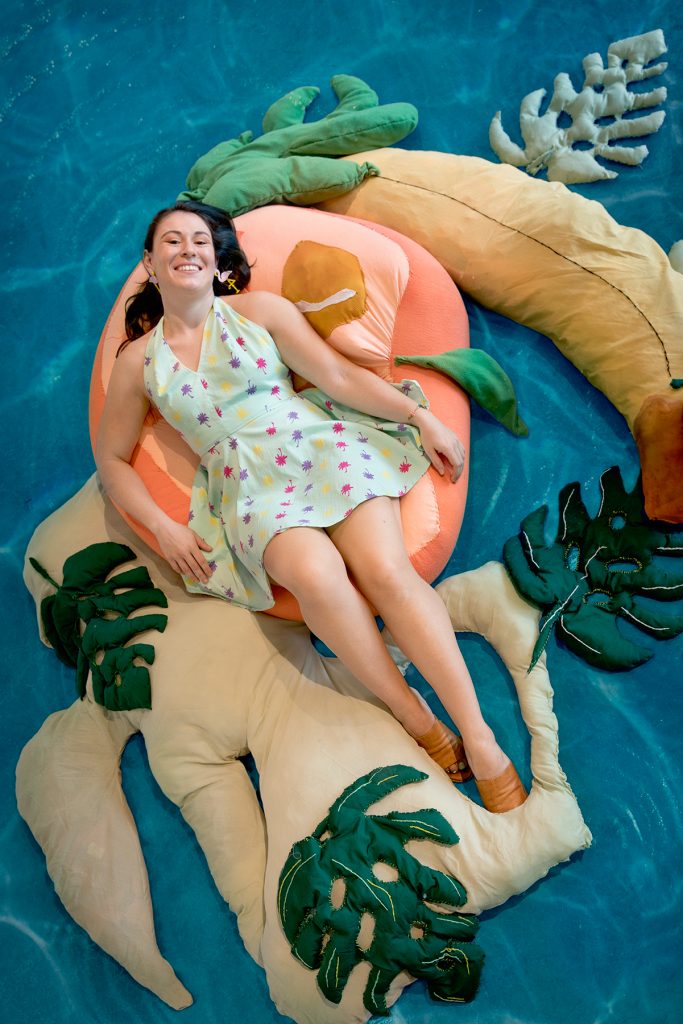
The Florida Room presents a series of works from Dodd Graduate students hailing from the Sunshine State. From the kitschy tourist views of flamingos and palm trees to the eerie mangroves and swamps of the Everglades, these artists deal with the tension between the natural and the artificial as it exists in Florida’s rapidly changing landscape. The exhibition was curated by Dodd Graduate student Cristina Echezarreta and featured the work of Nick Abrami, Dimelza Broche, Cristina Echezarreta, Paula Runyon, and Taylor Shaw. Echezarreta shown with her work Hey Cezanne, this is a still life too.
Visions of Florida
Five MFA students contemplated the symbology of their home state.
Speaking to his oversized postcard, Taylor Shaw says, “My process is a mix of several techniques. I usually have a gut reaction or aesthetic inspiration, followed by research and design into whatever I’m interested in, then comes the execution and build out for the piece. For my work in The Florida Room I was interested in vintage postcards and souvenir picture frames. Exaggerating the scale and using the photocentric nature of social media I designed and built pieces to function as backdrops or windows in which people could take photographs. Acting as their own souvenir that lives on social media.” Shaw also created a photo booth for the show.
Four of the five MFA students involved with the Florida Room, shown left to right: Dimelza Broche, Nick Abrami, Paula Runyon, and Cristina Echezarreta.
- Four of the five MFA students involved with the Florida Room, shown left to right: Dimelza Broche, Nick Abrami, Paula Runyon, and Cristina Echezarreta
- Dimelza Broche; Green Gators
- Nick Abrami; Hypnopompia
- Paula Runyon; Is This What it Feels Like to be on an Airboat?




